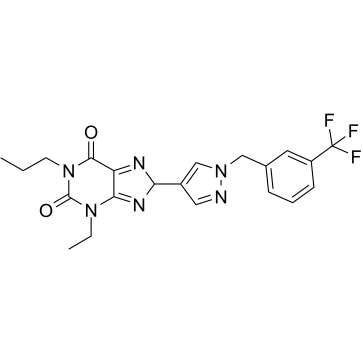GS 6201
Modify Date: 2024-01-11 17:48:27

GS 6201 structure
|
Common Name | GS 6201 | ||
|---|---|---|---|---|
| CAS Number | 752222-83-6 | Molecular Weight | 446.42600 | |
| Density | 1.44 | Boiling Point | 538.4ºC at 760 mmHg | |
| Molecular Formula | C21H21F3N6O2 | Melting Point | N/A | |
| MSDS | N/A | Flash Point | N/A | |
Use of GS 6201GS-6201 (CVT-6883) is a selective adenosine A2B receptor antagonist. GS-6201 displays high affinity and selectivity for the human adenosine A2B receptors (Ki=22 nM)[1]. GS-6201 reduces caspase-1 activity in the heart, and attenuates cardiac remodeling after acute myocardial infarction (AMI) in the mouse[2]. GS-62013 attenuates the airway reactivity induced by NECA, AMP, or allergen in sensitized mice[3]. |
| Name | 3-ethyl-1-propyl-8-[1-[[3-(trifluoromethyl)phenyl]methyl]pyrazol-4-yl]-8H-purine-2,6-dione |
|---|---|
| Synonym | More Synonyms |
| Description | GS-6201 (CVT-6883) is a selective adenosine A2B receptor antagonist. GS-6201 displays high affinity and selectivity for the human adenosine A2B receptors (Ki=22 nM)[1]. GS-6201 reduces caspase-1 activity in the heart, and attenuates cardiac remodeling after acute myocardial infarction (AMI) in the mouse[2]. GS-62013 attenuates the airway reactivity induced by NECA, AMP, or allergen in sensitized mice[3]. |
|---|---|
| Related Catalog | |
| Target |
Ki: 22 nM (human A2B receptors), 1070 nM (human A3 receptors), 1940 nM (human A1 receptors), 3280 nM (human A2A receptors)[1] |
| In Vivo | GS-6201 (CVT-6883) (4 mg/kg; i.p.; every 12 h for 14 days) significantly reduces IL-6, TNF-α, E-selectin, ICAM-1, and VCAM plasma levels[2]. GS-6201 (4 mg/kg; i.p.; every 12 h for 14 days) leads to a significant attenuation of left and right ventricular enlargement and dysfunction at 7 days, which was maintained at 14 days and also at 28 days[2]. GS-6201 (2 mg/kg; p.o.) treatment shows the Cmax, dAUC and t1/2 are 1110 ng/mL, 6500 ng h/mL, and 4.25 hours, respectively[1]. Animal Model: Adult out-bred male CD1 mice (8-12 weeks of age, AMI model)[2] Dosage: 4 mg/kg Administration: i.p.; every 12 h for 14 days Result: Significantly reduced IL-6, TNF-α, E-selectin, ICAM-1, and VCAM plasma levels. Animal Model: Sprague-Dawley rats[1] Dosage: 2 mg/kg Administration: p.o. (Pharmacokinetic Analysis) Result: The Cmax, dAUC and t1/2 were 1110 ng/mL, 6500 ng h/mL, and 4.25 hours, respectively. |
| References |
| Density | 1.44 |
|---|---|
| Boiling Point | 538.4ºC at 760 mmHg |
| Molecular Formula | C21H21F3N6O2 |
| Molecular Weight | 446.42600 |
| Exact Mass | 446.16800 |
| PSA | 90.50000 |
| LogP | 3.24680 |
| Index of Refraction | 1.64 |
| Storage condition | -20°C |
|
~% 
GS 6201 CAS#:752222-83-6 |
| Literature: US2006/58322 A1, ; Page/Page column 18; 21; 23 ; US 20060058322 A1 |
| 1H-Purine-2,6-dione,3-ethyl-3,7-dihydro-1-propyl-8-[1-[[3-(trifluoromethyl)phenyl]methyl]-1H-pyrazol-4-yl]-(9CI) |
| 1H-Purine-2,6-dione,3-ethyl-3,9-dihydro-1-propyl-8-[1-[[3-(trifluoromethyl)phenyl]methyl]-1H-pyrazol-4-yl] |
| 3-ETHYL-1-PROPYL-8-(1-(3-(TRIFLUOROMETHYL)BENZYL)-1H-PYRAZOL-4-YL)-1H-PURINE-2,6(3H,8H)-DIONE |
| 3-ethyl-1-propyl-8-(1-{[3-(trifluoromethyl)phenyl]methyl}pyrazol-4-yl)-1,3,7-trihydropurine-2,6-dione |
| CVT 6883 |
| 8-(1-(3-(trifluoromethyl)benzyl)-1H-pyrazol-4-yl)-3-ethyl-1-propyl-1H-purine-2,6(3H,7H)-dione |
![N-(6-amino-1-ethyl-2,4-dioxo-3-propyl(1,3-dihydropyrimidin-5-yl))(1-{[3-(trifluoromethyl)phenyl]methyl}-pyrazol-4-yl)carboxamide structure](https://image.chemsrc.com/caspic/165/752222-82-5.png)